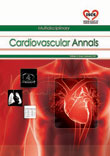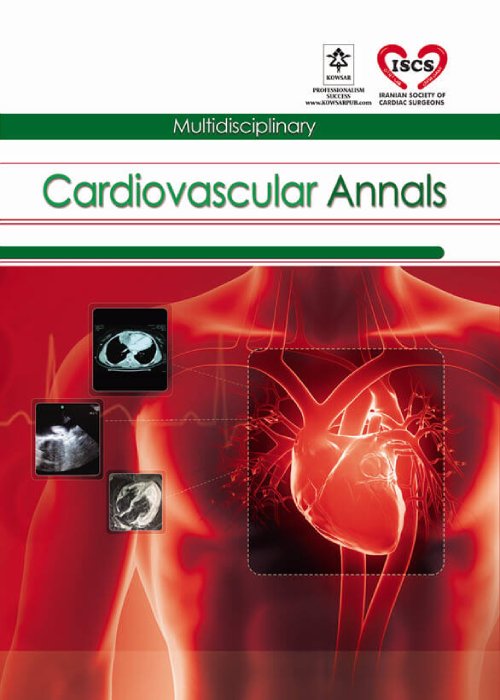فهرست مطالب

Multidisciplinary Cardiovascular Annals
Volume:8 Issue: 1, Jan 2017
- تاریخ انتشار: 1395/10/30
- تعداد عناوین: 6
-
-
Page 1Visual loss after nonocular surgery is rare but devastating. Peak rates of perioperative visual loss are with heart and spine surgery. The two possible main causes of visual loss after cardiac surgery are ischemic optic neuropathy and retinal ischemia due to embolism and / or low perfusion secondary to hemodynamic changes through cardiopulmonary bypass within the retinal, optic nerve and choroidal circulation. Stable preservation of some hemodynamic factors during cardiac surgery seems to be the key to stop visual loss. The purpose of this article is to briefly review perioperative visual loss after cardiac surgery.Keywords: Cardiac Surgery, Ischemic Optic Neuropathy, Retinal Vascular Occlusion, Perioperative Complication
-
Page 2BackgroundThere is concern about radiation dose in children during cardiovascular catheterization and many believe that the use of computerized tomography is much better than conventional catheterization and angiography. The aim of this study is to compare the radiation dose between diagnostic and therapeutic procedures in children.Methods178 patients with congenital heart disease enrolled in this study. Patients have been divided into 3 groups of CT angiography, conventional angiography and intervention. Data include: sex, age, weight, fluoroscopy time, total radiation dose of CT angiography, the amount of reference point air Kerma (Ka, r) (reference dose) and kerma area product (Pka) of fluoroscopy machine. Peak skin dose (PSD) was calculated for intervention and conventional angiography patients using the following formula: PSD = 249 5.2 × PKA. The data has been analyzed by SPSS version 20. In this study the P-value less than 0.05 was considered meaningful.ResultsThe patients were similar in sex, age and weight in all the three groups. The mean reference point air kerma (ka,r) in intervention group was meaningfully higher than the other two groups (PConclusionsGiven the results of this study, the use of fluoroscopy for diagnosis and treatment of pediatric cardiovascular diseases is safe but with due attention to sensitivity of children to some side effects of X-ray compared to adults, considering safety advices in order to reduce fluoroscopy time, radiation dose and the use of standard protection to reduce X-ray absorption is necessary.Keywords: Radiation, Congenital Heart Disease, Children
-
Page 3ObjectivesThe current study tries to assess the causative factors of dysphagia and omit them to find the exact contribution of TEE for this symptom among patients who suffer from elective open cardiac surgery in different age ranges in both sexes.MethodsIn this observational study, 100 patients between 30-80 years of age with ASA 40% who were candidate for elective open cardiac surgery in a referral hospital in Tehran in 2011 were recruited. The patients were divided into two groups based on TEE performance; patients who needed to perform TEE based on medical indication were considered the case group and the other patients who did not have indication for TEE, formed the control group.ResultsTotal frequency of dysphagia was 13% in all patients disregarding TEE performance while 6 (12%) and 7 (14%) of controls and cases showed this symptom respectively. Odynophagia was the other symptom to be assessed for its frequency in this study and showed 13% total frequency considering all participants disregarding the groups. This symptom was reported exactly similar to dysphagia which was 6 (12%) in controls and 7 (14%) in cases. The participants gender was not effective on the distribution of dysphagia where 6 (11.3%) females and 7 (14.9%) males were involved with no significant difference.ConclusionsIntraoperative trans-esophageal echocardiography during cardiac surgeries has greater usefulness than complications and is worth using in this case as well.Keywords: Transesophageal Echocardiography, Open Cardiac Surgery, Dysphagia, Odynophagia
-
Page 4BackgroundThe recent trend of cardiac transplantation has been dramatic in our center, thus entailing the interpretation of endomyocardial biopsies in such patients.ObjectivesWith this fact borne in mind, we decided to review the cases from the point of view of a certain diagnostic challenge, namely quilty lesion or effect.MethodsFrom April 2010 to December 2012, 42 patients with heart transplant have undergone endomyocardial biopsies and 63 samples were acquired.ResultsMean age of the patients was 30 ± 15.7 years (male/female: 34/8). Quilty effect was seen in 8 out of 63 samples (12.7%).ConclusionsThe incidence of quilty lesion was within the range defined for this finding. When the lesion extends to the underlying myocardial tissue, it can be a diagnostic challenge. In the eyes of an inexperienced observer, ISHLT grade 2 rejection may be diagnosed instead of invasive quilty lesion. Therefore, experienced pathologists play an important role in this regard in all the cardiovascular transplantation sites.Keywords: Heart Transplantation, Quilty Effect, Graft Rejection, Biopsy
-
Page 5IntroductionDilated pulmonary artery can increase the postoperative airway complications after the simultaneous repair of aortic arch anomalies and cardiovascular lesions with large left to right shunt. It is claimed that the anterior translocation of pulmonary artery will reduce the airway compression.Case PresentationHere we report 3 cases including an 11-month-old infant with ventricular septal defect (VSD) and coarctation, a 2-month-old infant with interrupted aortic arch (IAA) and VSD, and a neonate with aortopulmonary window (APW) in combination with coarctation in which all had a one stage repair of their lesions. Translocation of the right pulmonary artery (RPA) branch was performed in two patients, however with different postoperative courses that merit pondering over their fate.ConclusionsRPA anterior translocation could be considered as an additional palliation in some patients with coarctation repair from midsternotomy approach.Keywords: Coarctation of Aorta, Bronchial Stenosis, Midsternotomy, Pulmonary Artery Translocation
-
Page 6We present a 40-year-old man with a recurrent left atrial mass, previously diagnosed as cardiac myxoma elsewhere. His new admission was due to a regrowth of the mass. Progressive exertional dyspnea was his major complaint. A large lobulated tumor was seen in echocardiography in the posterior wall of left atrium involving the posterior leaflet of mitral valve, and resulting in severe stenosis and diastolic protrusion of the mass into the left ventricle. Surgery showed a non-homogenous myxomatous mass which infiltrated the posterior wall of the left atrium and parts of the inter-atrial septum. As a result, the surgeon excised parts of the septum and the posterior wall and did a reconstruction with pericardial patches. The pathologic examination revealed soft creamy-brown tumoral fragments, m: 10 × 4 cm altogether. Contrary to his previous diagnosis, we observed a malignant neoplasm with cells that had plump, round to oval nuclei, set in a myxoid and vascular background, but mitotic figures and necrosis were not conspicuous. Therefore, we made a diagnosis of recurrent myxoid round cell sarcoma and recommended immunohistochemical (IHC) studies. Multiple IHC and histopathological studies elsewhere favored a diagnosis of myxoma which was not compatible with our diagnosis. A second recurrent mass was soon found in the left atrium making further surgical attempts impossible. At last, a diagnosis of myxoid leiomyosarcoma confirmed our diagnosis, but the patient was not fortunate enough to survive and passed away before heart transplantation could be done as a remedy.Keywords: Heart Neoplasms, Rare Diseases, Leiomyosarcoma, Recurrence


